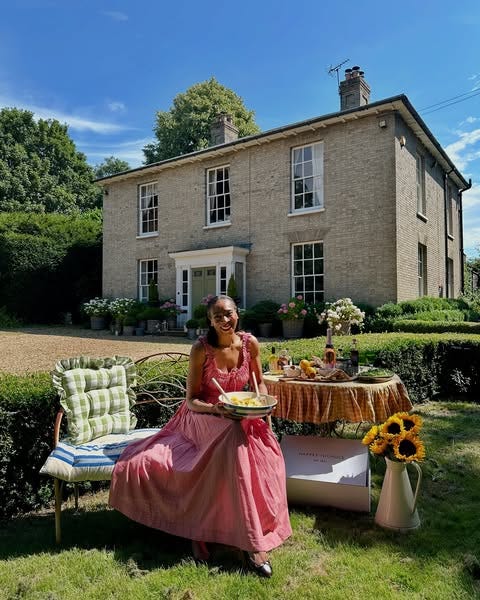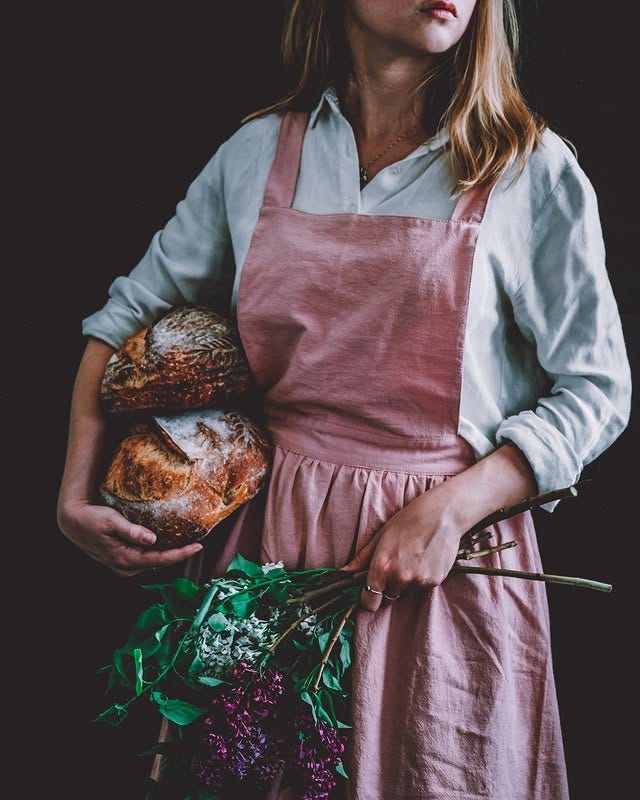Unpacking Virality: Lessons from the Cottagecore Aesthetic
No. 98 - Perspective on identity from my summer graduate class
Welcome to Style / Substance – Your weekly dose of personal style and confidence + analyzing the cultural influence of aesthetics and the psychology of what you wear and how you show up.
Here to make your life easier and help you present your best self, inside and out. If you enjoyed this week’s post, please tap the ❤️ above – I sincerely appreciate your support!
*Quick note: Whether you know or care about trends, distinctly “Cottagecore,” that went viral during the pandemic, and still remains today, I wrote this paper to dissect the specific microcosm, while at the same time, paint a picture of how network virality can function in our society. Almost like a case study.
My hope in sharing this, to encourage us to pause in times when trends really take off. I don’t have anything against trends (at least not all of them) as they do serve a function, which you’ll read below.
Typically, I don’t republish my graduate work, but for this particular paper, I decided to trust my instincts and let it out here. As always, dialogue is welcome in the comments or replies. I hope you have a few aha moments as I did while researching this…
The Allure of Cottagecore: An Evolutionary Perspective on Network Virality

Imagine you’re standing in front of one of Claude Monet’s ubiquitous water lilies paintings today. What feeling does this evoke? Now, close your eyes and transport yourself to the actual gardens in Giverny, France, where the artist lived and worked from the late 1880s through the first quarter of the 20th century. A halcyon mise-en-scène concocted of verdant lush, peppered with pinks, purples, whites, yellows, and hazy organic hues. The sun breaks through puffy clouds, illuminating the bucolic realm and washing away any stress or distractions that the rest of the world may hold. While the picture in your mind may be ephemeral, this illustration has come to life in a subset of today’s culture, taking the form of “cottagecore,” to the extent that the trend reached peak virality on TikTok and subsequent social media platforms during the COVID-19 pandemic in 2020-2021.
Cottagecore is a distinct aesthetic that romanticizes a simple, provincial lifestyle, reminiscent of the English countryside during the Victorian era, although it is not markedly tied to that particular period or location (Jephcote, 2023). At its layered core, like peeling an onion back, harkening a slower, nature-focused escapism mindset. The concept originated around 2018, and this way of life took root as the antithesis of the hustle and grind (Ramchandran, 2021, p.3). “It’s in part a reaction against capitalism and our increasing time spent in front of a screen, but also related to ongoing interests in wellness and sustainability, and more broadly the idea of social consciousness,” (Reggev, 2020). Soon after, the pandemic hit, and it accelerated the desirability, even if it was achieved only through a daydreaming phone screen. The labyrinthine motifs of cottagecore stretch into fashion, interiors, cooking, gardening, composting, knitting, DIY projects, picnicking, and strolling in fields. A leisure lifestyle is naturally embedded in its manifesto, which was only exacerbated during the stay-at-home orders. From there, it seeped into more urban dwellings as an extended form of comfort-seeking and has carried on in all manners of its “core” in today's subculture.
A few images that articulate the trend:
While the trending popularity of cottagecore can be attributed to proximate causes such as social media algorithms, pandemic-era escapism, and visual nostalgia, its enduring cultural power and virality stem from an ultimate explanation: identity and costly signaling. Cottagecore enables individuals, particularly women and queer communities, to adopt a curated aesthetic that conveys values such as simplicity, slowness, anti-modernity, and emotional refuge (Slone, 2020). Yet paradoxically, this pursuit of authenticity unfolds within hyper-digital, often commodified spaces, revealing a counterintuitive tension at its actual core. As these individuals seek to escape industrial modernity and reclaim a sense of self, they simultaneously participate in performative identity work shaped by the very forces they resist. In this way, cottagecore is not merely a trend but a symbolic system for negotiating identity, autonomy, and belonging in an era of mediated contradiction, all constituting in-group interplay.
Spillovers into identity signaling
Ramachandran & Hirstein (1999) and Pinker (1999) elaborate on the “cheesecake” effect of cottagecore through its overamplification of the aesthetic elements, including a visual overload of soft-focused yet strongly color-contrasted agrarian scenes, oversized sleeves on blouses evoking peak shift (Ramachandran & Hirstein, 1999, p. 18), and elaborately decorated sourdough loaves that are almost too pretty to eat. We know of these images in depth due to the proliferation of finely edited posts on social media that can be discovered under its hashtag #cottagecore. Although this is a spillover effect, each one doesn’t define the trend independently; rather, they are parts that add up to the sum. Therefore, alluding to identity signaling as the ultimate explanation for the cottagecore phenomenon.
While social traits in identity signaling can be blurred frequently (Smaldino, 2022, p. 234), cottagecore has many degrees of explicit articulations. Most notably, the clothing and ornamentation worn while conducting these domiciliary tasks serve as intentional cues. Clothing, whether overt or covert, functions as a visual marker for in-group identification, communicating alignment with the values of simplicity, femininity, and self-sufficiency. Notable fashion brands such as Dôen, Christy Dawn, and Free People embody the ethos of the style. The “nap dress” from the brand Hill House Home subsequently went viral during the cottagecore explosion due to its name and also the visual pattern and cut of the dress with a smocked bodice, ruffled sleeves, and tiered skirt, all of which live up to its name and this subculture's uniformity. Comfort and napping are key elements of this dynamic, after all (Haines, 2021). Thus, these sartorial choices go beyond mere costume; they operate as costly signals, requiring time, resources, and cultural knowledge to curate and purchase, thereby reinforcing group boundaries and strengthening perceptions of legitimacy and connection within the subculture.
Cottagecore’s aesthetic choices are not arbitrary; the elements do more than evoke nostalgia or serenity, they become symbolic tools. By curating imagery of slow living, domestic craft, and rural idyll, participants signal values of autonomy and intentionality, positioning themselves in contrast to the hyper-consumerist, fast-paced mainstream (Reggev, 2020). Thus, the bucolic cues serve as the lingua franca through which the deeper identity signaling takes place, and in some instances, buried signaling. They are, in essence, communicating to one another through their gingham colored lens and exposing their identity publicly on their feeds, planting their lifestyle ultimatum as a definitive character trait.
The clothing doesn’t stand alone as a costly signal within cottagecore. It is embedded within a broader set of practices that together communicate a curated identity. Looking at the leisure and domestic tasks associated with the aesthetic, there are costly behaviors at play all around (Hofbauer & Pawlowitsch, 2025). Consider the time-intensiveness that goes into baking artisanal bread, hand-sewing and knitting, cultivating a garden, or sourcing vintage items, all of which require significant investments of time, skill, and often financial resources. These activities function as high-cost signals that reinforce a genuine commitment to the lifestyle being portrayed. In this way, cottagecore’s visual and behavioral elements work in tandem to signal autonomy, resourcefulness, and intentional living to both insiders and external audiences.
Cottagecore du jour’s reach
Cottagecore’s rise to prominence is inextricably linked to the mechanics of network virality. As Rathje and Van Bevel (2025) note, internet memes and aesthetic movements spread through the participatory culture of sharing and resharing content within digital communities. Cottagecore lends itself particularly well to this circulation because of its visually cohesive and easily replicable tropes: soft, filtered images of pastoral scenes, flowing dresses, home-baked goods, and hand-crafted bits and bobs. These recurring symbols not only reinforce the aesthetic’s recognizable identity but also encourage viewers and followers, particularly those who identify with this group, to contribute their own variations, fostering a sense of belonging through co-creation and exchange. The meme-like and highly curated, therefore desirable, quality of cottagecore content enables rapid diffusion across platforms, transforming what might otherwise be a niche interest into a widely recognizable cultural phenomenon.
This virality is amplified by the algorithms and affective economies of platforms like TikTok and Instagram, which reward highly shareable, emotionally evocative content, emphasizing eye candy. The bite-sized videos and curated grids typical of the “core” aesthetic prioritize content that produces a reactive response (e.g., nostalgia, calm, longing), making cottagecore’s imagery algorithmically advantageous, especially at the height of the pandemic. This content functions as parasocial signaling, such that individuals, and in some cases influencers, perform their curated identities not only for peers but also for an unknown audience, gaining social capital from likes, comments, and follows. This dynamic strengthens the role of costly signaling within the aesthetic; the greater the audience reach, the more valuable the payoff for investing in time-consuming or resource-intensive displays of the lifestyle and opening up potential partnership and financial opportunities. In this way, virality does not merely spread the aesthetic; it magnifies its signaling function, increasing both the stakes and the rewards of participating in the cottagecore identity dance.
Counterpoints and cultural complications
Although there appears to be authenticity involved, it still derives a dialectical balance between the rejection of mainstream consumerism with the intersection of aesthetic commodification. “Both minimalism and cottagecore are wholly unrealistic depictions of life: so filtered by perfection that they’re not possible to reproduce in real life,” (Slone, 2020). This tension underscores one of the central critiques of cottagecore: that it thrives as a curated performance rather than an attainable lifestyle. While it romanticizes rural simplicity and domestic labor, it simultaneously relies on purchasing power to source the vintage and branded clothing, artisanal goods, and carefully staged decor that make the aesthetic legible online. This contradiction exposes how the movement’s anti-consumerist rhetoric is inextricable from capitalist modes of production and consumption.
Layered onto this is an intersectional critique, in that cottagecore often centers a narrow, privileged vision of domesticity that marginalizes those who cannot afford the time, labor, or resources to participate meaningfully in its practices. It's curated domestic labor ignores the real economic precarity tied to agricultural and household work while making these activities into leisurely, consumable performances. Yet these critiques, rather than undermining cottagecore’s appeal, actually reinforce its role as a selective signal. By requiring significant resources, cultural knowledge, and aesthetic fluency, participation becomes a costly display of authenticity and belonging, strengthening its value within this group's core identity.
Implications for identity signaling in digital culture
Cottagecore’s appeal and virality are best understood through the lens of identity signaling, particularly as framed by costly signaling. Far from being a mere aesthetic trend, it represents a complex system of visual and behavioral cues through which individuals communicate values of authenticity, autonomy, and belonging. By highlighting the time-intensive, resource-heavy, and culturally coded practices embedded in cottagecore, the aesthetic demonstrates a modern example of how costly signals operate in digital spaces and how network effect takes off.
This perspective adds an evolutionary lens to the cultural discourse around cottagecore, moving beyond surface-level interpretations of nostalgia or escapism. It identifies signaling and the strategic performance of identity for online audiences as a key mechanism driving the aesthetic’s success and widespread diffusion. More broadly, examining cottagecore in this way reveals how digital-age aesthetics fulfill enduring human needs: the search for belonging, the performance of meaningful identity, and the expression of self in ways that resonate with others. In doing so, it underscores how even the most seemingly niche internet trends reflect fundamental social and psychological dynamics that shape how we connect, signal, and find our place in an increasingly complex world.
* * * * *
References
Haines, A. (2024, October 30). How the nap dress rose to pandemic stardom. Forbes.https://www.forbes.com/sites/annahaines/2021/09/23/how-the-nap-dress-rose-to-pandemic-stardom/
Hofbauer, J., & Pawlowitsch, C. (2025). The evolutionary dynamics of costly signaling. International Journal of Game Theory, 54(1), 1–53.https://doi.org/10.1007/s00182-025-00927-5
Jephcote, E. J. (2023, December 20). The significance of Victorian England for the Cottagecore Aesthetic. English Studies at NBU, 9(2), 293–311. https://doi.org/10.33919/esnbu.23.2.8
Pinker, S. (1999). How the mind works (Norton pbk.). Norton.
Ramachandran, V. (2021). Urban-rural mobility during COVID-19: the growth of ‘cottagecore’in Australia and Aotearoa-New Zealand. MoLab Inventory of Mobilities and Socioeconomic Changes. Department ‘Anthropology of Economic Experimentation’. Halle/Saale: Max Planck Institute for Social Anthropology, 1-5.
Ramachandran, V. S., & Hirstein, W. (1999). The science of art: A neurological theory ofaesthetic experience. Journal of Consciousness Studies, 6(6–7), 15–51.
Rathje, S., & Van Bavel, J. J. (2025). The psychology of virality. Trends in Cognitive Sciences.https://doi.org/10.31234/osf.io/w742u_v2
Reggev, K. (2020, October 21). What exactly is Cottagecore and how did it get so popular?. Architectural Digest. https://www.architecturaldigest.com/story/what-exactly-is-cottagecore
Slone, I. (2020, March 10). Escape into Cottagecore, calming ethos for our febrile moment. The New York Times. https://www.nytimes.com/2020/03/10/style/cottagecore.html
Smaldino, P. E. (2022). Models of identity signaling. Current Directions in Psychological Science, 31(3), 231–237. https://doi.org/10.1177/09637214221075609






